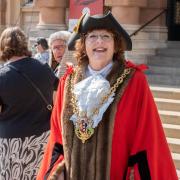Felixstowe, it seems, was home to Britain's very first beach huts. And more than a century later they're more popular than ever all along the coast. RUTH DUGDALL discovers why we love them so much
There isn’t a cloud in the sky and the North Sea is glittery with sunshine. A couple of teenage boys are riding a paddle board like it’s a horse, their laughter carries back to the shore where a couple sit on the sand, licking ice creams before they melt.
Along the prom, people sit beside cheerfully painted beach huts, chatting to passers by. Felixstowe is buzzing, and no wonder. Lockdown brought fresh appreciation for the attractions on our doorstep, and now we’re free to re-discover the blustery beauty of our own coastline. Beach huts are back in vogue.

It’s a bit of a mystery, that these sheds - let’s face it, that’s what they are - are so popular. They’re small, most don’t have electricity, and you can’t use them over night. Yet, very recently a Felixstowe hut made national headlines when it sold for an astronomical amount. Felixstowe was home to Britain’s very first beach huts, on the site of what is now the Spa Pavilion, and they are a signature feature of the town. So, what is it about beach huts that people love so much? And why are these particular huts so special? I visited three to find out...
Magical Times
“The sea is my healing place,” Sarah Caddick tells me, as she rests on a lounger in her hut. Before owning the hut, friends would bring her to the beach, and help her to the shoreline to paddle. On days when even that was too much for her, they’d bring her a bowl of sea water, to dip her feet in.
Sarah has ME, a multi-systemic condition which leaves her exhausted. At some points she has been bed-bound and even talking or eating felt a huge effort. She was diagnosed 21 years ago, and was medically retired from the teaching career she loved. Over the years, she’s learned to manage this debilitating illness by taking rests at two- to three-hour intervals. “It’s like running a marathon with flu,” she tells me. The beach hut has been her life-line.

Sarah’s long term partner lives in Ireland, so for 20 years they only saw each other periodically. He bought the beach hut, realising it was the answer to her convalescence, and they called it Magical Times, a reminder to treasure the infrequent time they spent together.
People have always used beach huts to improve their health. They trace their origin back to the bathing machines of the 1700s, when taking the sea air and sea-dipping was prescribed as a ‘water cure’. Felixstowe was a spa town and you can still see the dripping well which is fed by a mineral spring. At one time people could purchase a cup of it.
READ: The ghost airfields of Suffolk where that once defended Britain
Folk with all sorts of ailments would arrive in town, with prescriptions for a specified number of sea-dips. Doctors would even recommend this was done naked, which posed a problem for our prudish forbears. Hence, the ‘bathing machine’ was born. For a fee, the bather could enter a small shed on a wheeled platform, which was then pulled into the sea by horse or by pulley. The shivering bather would then re-appear in all their glory and a ‘sea dipper’ would assist by plunging them under the water, baptism-style.
Sarah’s dips in the sea sound much more pleasant. She arrives at her hut via mobility scooter, and takes regular rests inside. “My hut completely changed the quality of my life,” she says. Painted candy-floss pink, the hut is a cheery place with bright bunting draped along shelves of pretty mugs. It really is magical.
The visitor’s book
The second hut I visit is more like a superior hotel guest room, with a sage-green upholstered seat and an oak shelf, where a stove is warming the kettle. Duck-egg blue pots are stuffed with tea bags and biscuits, enough for everyone. The air is lightly perfumed by reed diffusers and scented candles. Everything is comfortable and welcoming, this is a place to leave your troubles behind. Great care has been taken, because the visitors who come here seek solace.
Looking up, you can see an impressive red-brick building with enormous stone balconies. Designed by Thomas Cotman, The Felix Hotel (now Harvest House) opened its doors to guests in 1903, and was quickly dubbed the ‘Millionaire’s Hotel’. With its opulent palm court for dancing, and fabulous Art Deco features, it was the perfect spot for wealthy pleasure-seekers. It’s easy to imagine it during its hey-day, the Daimler pulling up to the front door, tipping out giddy holiday-makers who would soon take to the marble floor to dance the Charleston. History is so close here, you can almost hear their ghostly laughter drifting on the breeze.

There’s laughter in the hut too. In a wicker basket is a collection of beach toys, the joy of the little girl who plays here. But there should be two children; she had a twin brother, who sadly died. The beach hut is named for him, and is a safe space to grieve, and also to celebrate his sister.
The mum had a second painful experience, when she was diagnosed with breast cancer. She came to the hut after chemotherapy sessions, to rest and heal, as she watched the waves. Now fully recovered, her surgeon asked if she’d be willing to chat with others going through treatment. They come to the hut, for support and solace, and sign the visitor’s book when they leave. “I want to bless people with the peace I’ve experienced here, in the darkest of times,” she says. I imagine they leave, feeling a little better, treading a little lighter.
Salty Kisses
“This beach hut is part of us,” Lynn tells me, as we watch her two granddaughters scramble on the rocks. As we chat, several people stop to admire the eye-catching hut. It’s painted forget-me-not blue, and inside is an array of curiosities she's collected, magpie-like, to make her hut a home. The doors are trimmed with fishing nets and shells, there are colourful curtains and cushions, a sign says ‘Welcome’. Others declare that ‘Life is better at the beach’ - and Lynn couldn’t agree more.
Life was difficult, back when she bought the hut. In October 2012 she lost her husband, very suddenly, when he was only 60. A few months later, during a trip to the beach with her granddaughter, Lynn said: “Wouldn’t it be lovely to own one of those huts, Evie?” The pair walked along the row, and spotted a ‘For Sale’ sign. Within the hour, the hut had a new owner. And for Lynn, it was the start of a new chapter of her life, with a special place called Salty Kisses to enjoy with her family.

Above us is South Beach Mansions. In July 1891, the Empress Augusta Victoria of Prussia stayed here, putting Felixstowe firmly on the tourist map. Augusta’s grandmother was Queen Victoria’s half-sister. Her husband, Kaiser Wilhelm, was the queen’s grandson, so she called in on her royal relative, before she boarded a special train to Felixstowe for a family holiday. Augusta used a bathing machine and her five sons enjoyed the beach.
It was just a few years later, in 1895, that beach huts were first photographed where the Spa Pavilion is now. Felixstowe, therefore, was most likely the first British resort to have beach huts. “Felixstowe can claim this honour,” says Kathryn Ferry, an author expert on beach hut history.


The site, and the huts on that part of the prom, are therefore historically important. “These huts are special,” Lynn agrees. “Not just for people who use them, but also those who stop and chat. It makes people happy.”
Walking away, I see people’s faces, and think she’s right. On their faces, are the wistful smiles of the joy we experience when we happen upon something special or unique, like a classic car or a precious moment. These huts are more than sheds. They are places of human experience, in all its richness, and a living piece of history of which our resorts can be rightly proud.
SUBSCRIBE: Get Suffolk magazine every month and discover more great stories about the county



























